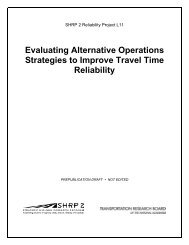Contemporary Approaches to Parking Pricing: - FHWA Operations
Contemporary Approaches to Parking Pricing: - FHWA Operations
Contemporary Approaches to Parking Pricing: - FHWA Operations
Create successful ePaper yourself
Turn your PDF publications into a flip-book with our unique Google optimized e-Paper software.
Results from the 2011 rate adjustments found that in four districts where<br />
rates were increased, occupancy subsequently dropped. In seven districts<br />
where rates remained the same, occupancy sometimes went up and sometimes<br />
went down. In the eleven districts where rates were decreased, there<br />
was no significant change in occupancy. The city found that in areas where<br />
parking occupancy has traditionally been low, rate reductions did not attract<br />
new parkers. The city is now testing <strong>to</strong> see if increasing parking time<br />
limits from 2 <strong>to</strong> 4 hours in low-demand areas increases occupancy. Data<br />
from SDOT’s most recent price and time limit adjustments will be available<br />
in the fall of 2012.<br />
Since implementing performance-based parking, the city has worked <strong>to</strong><br />
identify more efficient ways in which <strong>to</strong> collect on-street parking condition<br />
data. While the city is not currently pursuing street-sensor technology,<br />
SDOT has investigated several other ways <strong>to</strong> collect occupancy data. In one<br />
effort, SDOT is examining payment transaction data <strong>to</strong> estimate occupancy.<br />
Unfortunately, in several areas, paid occupancy is lower than actual<br />
occupancy and the difference varies by time of day and area. The primary<br />
reason for the difference is disabled permit parking; vehicles with Stateissued<br />
disabled parking permits are allowed <strong>to</strong> park for free and for an unlimited<br />
period in paid parking neighborhoods.<br />
A second data collection effort involved the use of Seattle Police<br />
Department resources. <strong>Parking</strong> enforcement officers were trained in the<br />
data collection process and used for two of the four completed studies;<br />
however, it was determined that the time they spent assisting with the<br />
parking study pulled them unreasonably from their primary enforcement task. In a third effort, SDOT tried <strong>to</strong> use<br />
its LPR enforcement equipment <strong>to</strong> determine occupancy levels, but was unsuccessful. The match between the locations<br />
of license plate reads and the paid-parking block faces was <strong>to</strong>o imprecise for use in a parking study.<br />
Throughout development and implementation of the performance-based parking process, SDOT has actively engaged<br />
community stakeholders. This has been accomplished through the creation of a <strong>Parking</strong> Sounding Board<br />
made up of a wide variety of community stakeholders who discuss and comment on changes in paid-parking rates<br />
and hours of operation. SDOT has also involved local neighborhood groups and chambers of commerce and is<br />
producing neighborhood-specific information for distribution. Going forward, SDOT is also working <strong>to</strong> identify<br />
new ways <strong>to</strong> communicate parking rate changes <strong>to</strong> the public.<br />
Pho<strong>to</strong> credit: City of Seattle<br />
C o n t e m p o r a r y A p p r o a c h e s t o P a r k i n g P r i c i n g | 37















